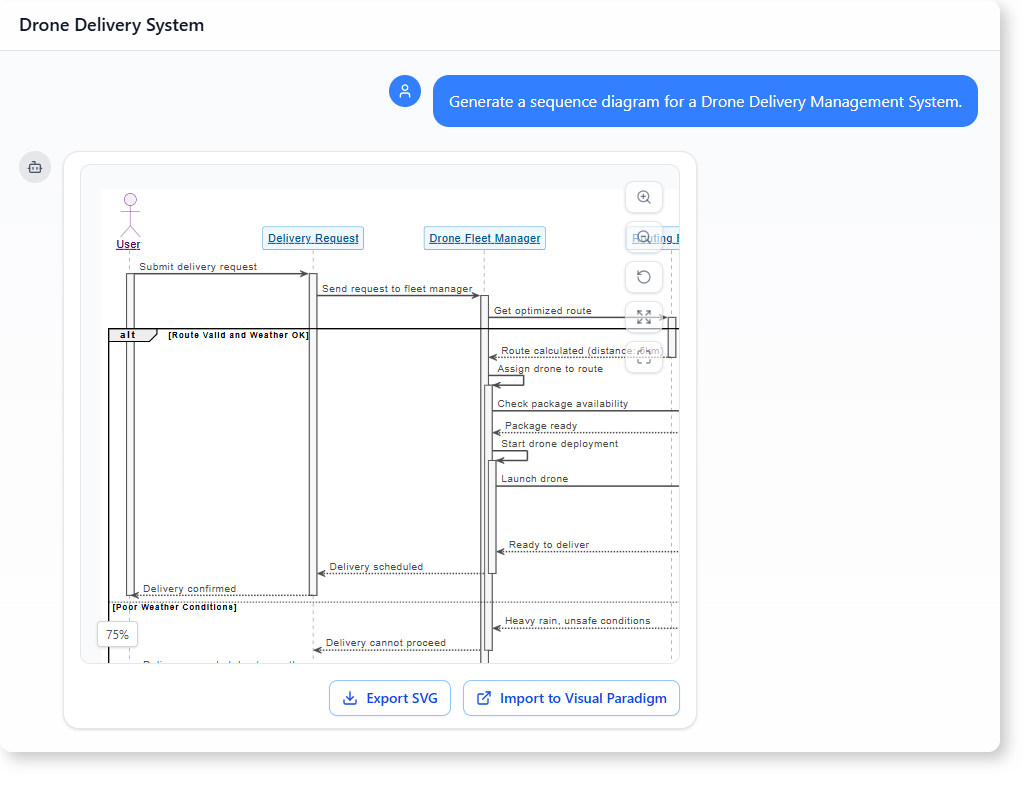Now Reading: How to Generate a Drone Delivery System Sequence Diagram with AI-Powered Modeling Software
-
01
How to Generate a Drone Delivery System Sequence Diagram with AI-Powered Modeling Software
How to Generate a Drone Delivery System Sequence Diagram with AI-Powered Modeling Software
How to Generate a Drone Delivery System Sequence Diagram with AI-Powered Modeling Software
Imagine a user submitting a delivery request. The system checks the route, evaluates weather, and ensures the package is available before launching a drone. All of this unfolds in a clear, step-by-step flow.
This is exactly what happens in a drone delivery management system. And with the right AI-powered modeling software, you can generate that entire sequence—complete with decision points and critical interactions—just by describing the process.

The User’s Journey: From Idea to Sequence Diagram
The user is part of a logistics team evaluating how to modernize delivery operations. They need to understand the end-to-end workflow of a drone delivery system—not just the steps, but how decisions impact the outcome.
Instead of manually drawing a sequence diagram, they want to see the full flow in one place, including conditions that stop the process, like bad weather or stock issues.
They decide to use an AI chatbot integrated into AI-powered modeling software. Their goal? To generate a sequence diagram that highlights the critical interactions and decision points in a drone delivery system.
Step-by-Step Interaction with the AI Chatbot
-
Prompt: “Generate a sequence diagram for a Drone Delivery Management System.”
The AI interprets this as a request to build a flow chart showing the interaction between a user, delivery request, fleet manager, routing engine, weather service, and warehouse.
It creates a sequence diagram that starts with the user submitting a delivery request and flows through the system, showing each participant and their actions.
-
Prompt: “Highlight the critical interactions and decision points in this sequence diagram.”
The AI doesn’t just generate the diagram—it adds structure. It identifies the key decision points, such as weather conditions and package availability, and marks them with conditional branches.
The diagram now clearly shows:
-
The flow of responsibilities between system components
-
When the process stops due to weather or out-of-stock issues
-
How the system responds to each condition
These are not just lines—they represent real-world constraints that affect delivery success.
Why This Matters for Real-World Systems
A well-designed sequence diagram is more than a visual aid. It becomes a communication tool that helps teams:
- Understand the order of events
- Spot bottlenecks or failure points
- Plan fallback strategies
In the drone delivery system, the AI-powered modeling software shows the moment when weather is checked—before any drone is launched. This is a critical interaction. Without it, the system could launch into unsafe conditions.
Similarly, the check for package availability prevents failed deliveries due to missing inventory. These aren’t just details—they are guardrails.
The diagram clearly shows two decision paths:
- Clear weather and package available → Delivery proceeds
- Poor weather or out of stock → Delivery is canceled or delayed
This clarity helps teams design better rules, improve automation, and build more reliable systems.
What You Get with AI-Powered Modeling Software
When you use this tool, you don’t get a generic flow. You get:
- A clear, interactive sequence diagram that shows the exact order of actions
- Decision points marked with conditions that change the flow
- Real-world context built into the interactions
- A focused view of the critical interactions in a sequence diagram
This is not just a diagram. It’s a working model of how the system behaves under different conditions.
Is This the Right Tool for Your Project?
If you’re working on a system where interactions matter—like logistics, healthcare, or smart manufacturing—you’ll find this approach valuable. You don’t need to write code or use complex tools. You describe the process, and the AI generates a clear, usable diagram.
This is especially useful when:
- You’re new to system modeling
- You need to explain a process to non-technical stakeholders
- You want to visualize conditional behavior in your system
Frequently Asked Questions
How does AI help in creating sequence diagrams?
AI takes natural language input and converts it into a structured sequence diagram. It understands the flow of actions, identifies decision points, and builds them into the model. This saves time and reduces errors compared to manual creation.
Can this tool help with systems that have multiple failure paths?
Yes. The AI identifies conditions that lead to different outcomes—like weather issues or inventory problems—and shows them as branching paths. This makes it easier to see how a system handles edge cases.
Is the generated diagram easy to understand for non-technical users?
Yes. The diagram uses clear labels, simple flow, and visual cues for decisions. It avoids technical jargon and focuses on the real-world actions and outcomes.
What makes AI-powered modeling software different from traditional tools?
Traditional tools require setup, syntax, or technical knowledge. This AI-powered modeling software works by conversation. You describe the system, and the tool builds the diagram. It’s faster, more intuitive, and focused on real-world problem solving.
Ready to map out your system’s interactions? Give our AI-powered modeling software a try at Visual Paradigm’s AI Chatbot today!.
